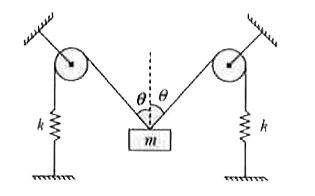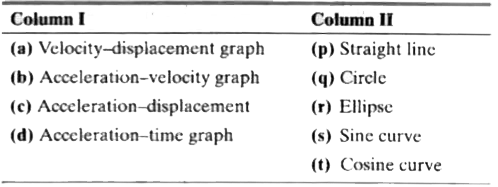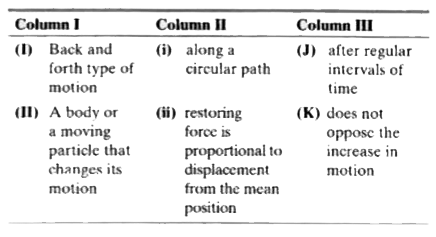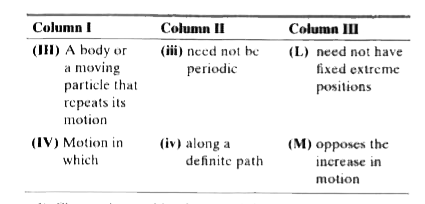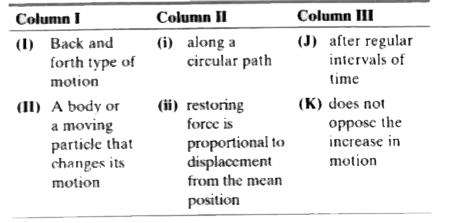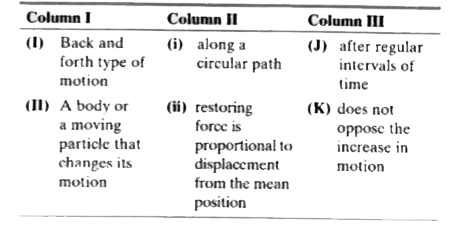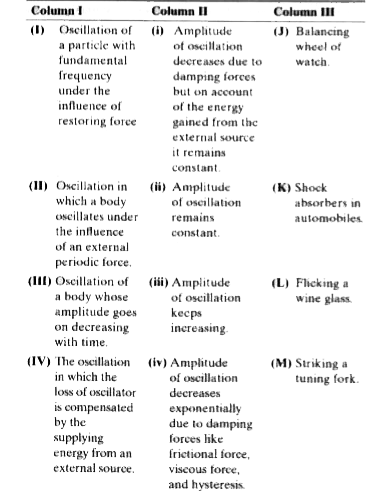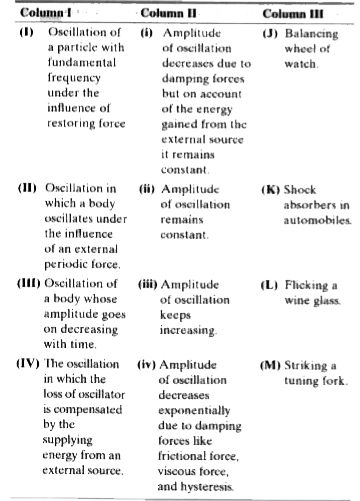Practice Questions from RESNICK AND HALLIDAY PHYSICS (HINGLISH) OSCILLATIONS for Class 12
| Class 12 | PHYSICS |
| Chapter | OSCILLATIONS |
| RESNICK AND HALLIDAY PHYSICS (HINGLISH) | Practice Questions |
| Medium | English |
| Academic Year | 2023-2024 |
Question 18
The length of a simple pendulum is 0.79m and the mass of the particle (the ''bob'') at the end of the cable is 0.24kg. The pendulum is pulled away from its equilibrium position by an angle of 8.50∘ and released from rest. Assume that friction can be neglected and that the resulting oscillatory motion is simple harmonic motion. What is the angular frequency of the motion?View SolutionQuestion 19
A block is attached to a horizontal spring and oscillates back and forth on f frictionless horizontal surface at a frequency of 3.00Hz. The amplitude of the motion is 5.08×10−2m. At the point where the block has its maximum speed, it suddenly splits into two identical parts, only one part remaining attached to the spring. What is the amplitude and the frequency of the simple harmonic motion that exists after the block splits?View SolutionQuestion 20
A copper rod (length =2.0m, radius =3.0×10−3m) hangs down from the ceiling. A 9.0kg object is attached to the lower end of the rod. The rod acts as a ''spring'' and the object oscillates vertically with a small amplitude. Ignoring the rod's mass, find the frequency f of the simple harmonic motion.View SolutionQuestion 21
Two physical pendulums (not simple pendulums) are made from meter sticks that are suspended from the ceiling at one end. They are identical, except that one is made of wood and the other of metal. They are set into oscillation and execute simple harmonic motion. The wood and metal pendulums have masses of 0.17 and 0.85kg, respectively. Determine the period of wood pendulum.View SolutionQuestion 28
A simple pendulum consists of a ball of mass m suspended from the ceiling using a string of length L. The ball is displaced from its equilibrium position by a small angle θ. What is the magnitude of the restoring force that moves the toward its equilibrium position and produces simple harmonic motion?View SolutionQuestion 29
An iron ball hangs from a 21.5m steel cable and is used in the demolition of a building at a location where the acceleration due to gravity is 9.75m/s2. The ball is swung outward from its equilibrium position for a distance of 4.20m. Assuming the system behaves as a simple pendulum, find the maximum speed of the ball during its swing.View SolutionQuestion 41
A (hypothetical) large slingshot is stretched 2.30 m to launched a 170 g projectile with speed sufficient to escape from Earth (11.2km/s). Assume the elastic bands of the slingshot obey Hooke's law.
What is the spring constant of the device if all the elastic potential energy is converted to kinetic energy?View SolutionQuestion 42
A (hypothetical) large slingshot is stretched 2.30 m to launched a 170 g projectile with speed sufficient to escape from Earth (11.2km/s). Assume the elastic bands of the slingshot obey Hooke's law.
Assume that an average person can be exert a force of 490 N. How many people are required to stretch the elastic bands?View SolutionQuestion 46
A block weighing 10.0 N is attached to the lower end of a verticle spring (k=200.0N/m), the other end of which is attached to a ceiling. The block oscillates vertically and has a kinetic energy of 2.00 J as it passes through the point at which the spring is unstretched.
What is the period of the oscillation?View SolutionQuestion 47
A block weighing 10.0 N is attached to the lower end of a verticle spring (k=200.0N/m), the other end of which is attached to a ceiling. The block oscillates vertically and has a kinetic energy of 2.00 J as it passes through the point at which the spring is unstretched.
Use the law of conservation of energy to determine the maximum distance the block moves both above and below the point at which the spring is unstretched (these are not necessarily the same)View SolutionQuestion 48
A block weighing 10.0 N is attached to the lower end of a verticle spring (k=200.0N/m), the other end of which is attached to a ceiling. The block oscillates vertically and has a kinetic energy of 2.00 J as it passes through the point at which the spring is unstretched.
What is the amplitude of the oscillation and the maximum kinetic energy of the block as it oscillates?View SolutionQuestion 56
When a 20 N can is hung from the bottom of a vertical spring, it causes the spring to stretch 20 cm. The spring is now placed horizontal on a frictionless table. One end of it is held fixed, and the other end is attached to a 5.0 N can. The can is then moved (stretching the spring) and released from rest. What is the period (in×10−2s) of the resulting oscillation?View SolutionQuestion 57
An engineer has odd-shaped 10 kg object needs to find its rotational inertia about an axis through its center of mass. The object is supported on a wire stretched along the desired axis. The wire has a torsion constant k=0.50N.m. If this torsion pendulum oscillates through 20 cycles in 50 s, what is the rotational inertia (in10−2kgm2) of the object?View Solution

